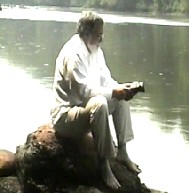The Revelation of Jesus Christ
Structure of the Book of Revelation
From a high level, the Revelation of Jesus Christ has a simple and straight forward structure, that communicates the core message of John's vision. It begins with John describing the vision he saw of the Son of Man. This is the glorified Jesus in His full authority, walking among His churches. There follows seven letters to seven churches. These letters reveal the spiritual state of each church and admonish them to overcome their weaknesses and strive toward the reward for overcoming. Then follows the main portion of John's vision. It is here that as we read we find ourselves thrashing and seeking meaning and understanding. It is not so much that each paragraph cannot bring forth an understandable picture, but the flow of images and their connections among themselves are mysterious. Nevertheless, the message, at the highest levels, is easily seen:
- The Throne of God is in Heaven (Revelation 4, 5)
- Seven Profiles of the Future (Revelation 6-20)
- The Throne of God is on a New Earth (Revelation 21,22)
The above outline works for all four interpretive modes. John's vision is about bringing God and mankind together.
Of course, that middle section again is a strange and difficult read. One reason for this is that we seem to read about the same events multiple times. When the Lamb breaks the sixth seal, the wrath of God comes:
Then I looked when the Lamb opened the sixth seal, and a huge earthquake took place; the sun became as black as sackcloth made of hair, and the full moon became blood red; and the stars in the sky fell to the earth like a fig tree dropping its unripe figs when shaken by a fierce wind. The sky was split apart like a scroll being rolled up, and every mountain and island was moved from its place. Then the kings of the earth, the very important people, the generals, the rich, the powerful, and everyone, slave and free, hid themselves in the caves and among the rocks of the mountains. They said to the mountains and to the rocks, “Fall on us and hide us from the face of the one who is seated on the throne and from the wrath of the Lamb, because the great day of their wrath has come, and who is able to withstand it?” (Revelation 6:12-17, The Net Bible)
But chapter 7 appears to have nothing to do with the dramatic events at the end of chapter 6. Then later, at the blowing of the seventh trumpet, the wrath of God again seems to come:
Then the seventh angel blew his trumpet, and there were loud voices in heaven saying: “The kingdom of the world has become the kingdom of our Lord and of his Christ, and he will reign for ever and ever.” Then the twenty-four elders who are seated on their thrones before God threw themselves down with their faces to the ground and worshiped God with these words: “We give you thanks, Lord God, the All-Powerful, The one who is and who was, Because you have taken your great power And begun to reign. The nations were enraged, but your wrath has come, and the time has come for the dead to be judged, and the time has come to give to your servants, the prophets, their reward, as well as to the saints and to those who revere your name, both small and great, and the time has come to destroy those who destroy the earth.” (Revelation 11:15-18)
But chapter 12 appears to have nothing to do with the proclamation at the end of chapter 11. And so it goes, we seem to be at the end, but then we are not, then we are, then we are not.
That is why, in the outline above, I group chapters 6 through 20 as Seven Profiles. Here they are:
- Seven Seals and an Interlude
- Seven Trumpets and an Interlude
- Seven Persons and an Interlude
- Seven Bowls and an Interlude
- Babylon's Destruction
- The Kingdom Established
- The Final Battle and Judgment
Here is the key, I believe, that can make sense of John's vision. Each of the profiles tells the same story from a different point of view and its own timeline. The interludes represent a vision of the people of God within the flow of events in that profile. The interludes also have separate timelines.
- The seven seals focus on what is physically happening to the earth.
- The seven trumpets focus are the spiritual and demonic.
- The seven persons focus on the main players in the drama: Israel, Jesus, Satan, etc.
- The seven bowls focus on the justice of God's wrath.
- Babylon focuses on the source of evil
- The Kingdom speaks of Jesus reign on earth before evil is destroyed
- The Final Battle is about the final removal of evil from creation
In other words, the book of Revelation is not chronological. It is thematic. The first profile might well cover many many years, while the fifth seems to cover a few hours. What is important is that each concludes with the return of Jesus to the earth to reign.
Perhaps this will help you read and get more from the book.
Wednesday: Daniel, Zechariah, and John
<>< Test Everything. Cling to what is good. ><>



0 Comments:
Post a Comment
<< Home